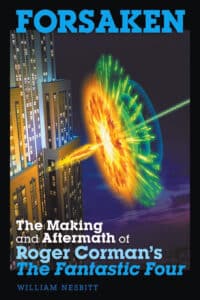
Yet, in 1994, the fantastic foursome ran smack into the one fearsome foe they couldn’t vanquish: the Hollywood machine. A film featuring the comic-book superheroes secretly was made on the cheap ($1 million budget) by B-movie king Roger Corman (“Little Shop of Horrors;” “The Man with the X-Ray Eyes;” “The House of Usher”). Alas, Corman’s cheapie never was meant to see the light of day.
Why?
That’s the cosmic mystery into which Beacon College humanities professor and pop culture expert Dr. William Nesbitt delves in his new book Forsaken: the Making and Aftermath of Roger Corman’s “The Fantastic Four.”
Below, he offers a peek into one of the weirdest of weird Tinseltown tales.
Q: How did you become interested in this subject?
A: I’ve been working for a couple of years on an interview project with some friends about

Roger Corman and New World Pictures. I finished my part, had some time left, and reviewed Corman’s filmography to see if there was anything else I wanted to take a final shot at. I saw his name attached to “The Fantastic Four,” which seemed kind of surreal — like if Lloyd Kaufman did “Star Wars.” I’ve always been into comics so that was really interesting to me.
I started contacting the director and a few actors hoping maybe one would respond because for about every four to six shots with the main project, I could get one person for an interview. All four people I reached out to responded, so my idea was to do four interviews and compile them into a sort of roundtable interview to include as an appendix for the main project because, while it was Corman, it wasn’t made during his New World Pictures era.
It just started growing. People started putting me in touch with more people for the film such as Mark Sikes and Marty Langford who made a documentary on it a few years ago called “Doomed! The Untold Story of Roger Corman’s ‘The Fantastic Four’.” Some folks had photographs that have not been previously published. It took on this energy and life and vision of its own. I just had to follow that. With the blessing of my friends, I broke that off from the main project and it blossomed into Forsaken.
Q: Roger Corman has made at least 159 films, according to some sources, but his “The Fantastic Four” is the only one never released. What’s the short story behind that?
A: Bernd Eichinger had the rights to make the film but needed Roger Corman and his post-New World Pictures studio Concorde-New Horizons to make and distribute it. They get the film shot but before the premiere Marvel steps in and buys it up — though Eichinger is a co-producer on the first big-budget “Fantastic Four” in 2005. Marvel never acknowledges the Corman version and they don’t speak about it. For Marvel, this film does not exist. The story is Avi Arad (who served as chief creative officer of Marvel Entertainment, a Marvel director and the chair, CEO and founder of Marvel Studios) had all the prints destroyed.
Q: So was Corman’s film a sham or just a series of unfortunate events?
A: Eichinger had to get something out to hold onto his option. Was this his only goal? Was he keeping his choices open? What did Corman know? Who knew what when? You can talk to the cast and even they have different opinions on these matters. I come to some pretty definite conclusions the book, but the evidence is conflicting.
Let me give you an example. The film had an exact date and location scheduled for its premiere. Michael Bailey Smith (Ben Grimm) and Alex Hyde-White (Mister Fantastic) were travelling and doing promotion for this film. Film Threat put the film on its cover and gave them a huge article. I have a poster of the film and other promotional materials Corman made. In the meantime, director Oley Sassone was having footage snuck into him at Concorde-New Horizons while he was making another film because resources disappeared for “The Fantastic Four.” Marks Sikes who had like eight jobs at the studio got into the Thing suit to finish a scene because all the actors had been told their work was done. You reconcile that one.
Q: Sci-Fi Universe magazine called Corman’s “The Fantastic Four” “a mess” and “one (lost) movie that deserves to be lost.” Yet, the three big budget versions haven’t been box office magic either, and Corman’s canned cult classic version appears to be a fan favorite among the Fantastic Four films. Guesses why?
A: It’s fun, fun, fun. You can watch this movie and have so much fun. The film focuses on story and character — not special effects. That’s where the later films went wrong. And the 1994 version follows the original comics a lot closer. Yes, the special effects are not perfect. Some of that is the time it was made in, in terms of both the era it was made and the amount of time they had to make it, and some of that is how viewers are experiencing it. You can see it on YouTube through a laptop or on a phone. That doesn’t compare to the experience of seeing and hearing it in a theater. Plus, the versions running around are copies of copies of a VHS copy. Seeing it in an actual theater with an audience or even in a decent home theater setup with 5.1 surround sound and a big screen would be a totally different experience. Oley and his people got it right, maybe not perfect, but right. Marvel is still trying. Here are some stats from Rotten Tomatoes. The percentage is an average of critics’ scores: “The Fantastic Four” (1994) 33 percent, “Fantastic Four” (2005) 27 percent, “Fantastic Four: Rise of the Silver Surfer” (2007) 37 percent, and “Fantastic Four” (2015) nine percent. I rest my case. It ain’t that bad.
Q: In a 2015 interview with SyFy Wire, Corman — comparing his film to the 2005 “Fantastic Four” film — said he thought, “we made a pretty good film. Better than that, we made a good little film for a million dollars. … I thought it would play. So I was a little disappointed.” Had his “The Fantastic Four” been released how different do you think the landscape of superhero films would be today?
A: Great question. People’s expectations were different in 1994 and I think they would have been kinder to this movie than some critics are now looking back from the vantage point of 25 years later in an era of comic movies with $100 million budgets.
A lot of it would have come down to how it did at the box office, which we can only speculate. I think it would have made its money back and some profit. If it had done that, I could see a sequel being made and then there would have been more money, time, and other resources for that sequel. The whole thing would have gained momentum. So because it was stuck down before it had a chance to walk, it’s not just the movie that never was; it’s the franchise that could have been.
I think it might have helped point the studios in the direction of making movies based on story, character, and cohesive plot rather than splashy effects, mile-a-minute action sequences that sometimes don’t add up to much, and wobbly plots. We might have had a little less flash and little more substance like “Logan” and the 2009 “Watchmen.”